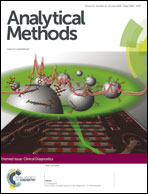Application of polyaniline–nylon-6 nanocomposite, GC-MS and chemometrics for rapid and comprehensive analysis of Zingiber officinale fragrance components
Abstract
Ginger (Zingiber officinale) headspace has been extracted using a novel polyaniline–nylon-6 (PANI–N6) nanocomposite fabricated by electrospinning. GC-MS (gas chromatography-mass spectrometry) and chemometrics have been used to identify the components of the fragrance. Chemometric resolution techniques were utilized to improve the resolution, qualitative and quantitative determination of co-eluted compounds in GC-MS. In this way, chromatographic problems such as baseline/background contribution, low S/N peaks and co-elution occurring during chromatographic analysis were solved. Moreover, principal component analysis was used to determine hidden structures and to identify those volatiles which were most differentiated between the fragrance and the essential oil of ginger. The results show that the fragrance and the essential oil of ginger are different enough in terms of chemical composition to put them into two distinct classes using 17 components which account for most of the variation. Among the 62 identified components of ginger fragrance, α-phellandrene (18.14%), α-zingiberene (16.45%), (E,E)-α-farnesene (7.21%), camphene (5.47%) and geranial (4.38%) are the major components. The results proved that the present procedure may be useful for the comprehensive analysis of complex natural aromas such as ginger fragrance.


 Please wait while we load your content...
Please wait while we load your content...